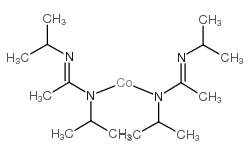Bis(N,N'-di-i-propylacetamidinato) cobalt(II)
Modify Date: 2024-01-02 21:32:41

Bis(N,N'-di-i-propylacetamidinato) cobalt(II) structure
|
Common Name | Bis(N,N'-di-i-propylacetamidinato) cobalt(II) | ||
|---|---|---|---|---|
| CAS Number | 635680-58-9 | Molecular Weight | 341.40100 | |
| Density | N/A | Boiling Point | 50ºC 50mm | |
| Molecular Formula | C16H34CoN4 | Melting Point | 72ºC | |
| MSDS | N/A | Flash Point | N/A | |
| Name | Bis(N,N'-di-i-propylacetamidinato) cobalt(II) |
|---|
| Boiling Point | 50ºC 50mm |
|---|---|
| Melting Point | 72ºC |
| Molecular Formula | C16H34CoN4 |
| Molecular Weight | 341.40100 |
| Exact Mass | 341.21200 |
| PSA | 31.20000 |
| LogP | 3.97580 |
|
Section 1: Product Identification Chemical Name:Bis(N,N'-di-i-propylacetamidinato)cobalt (II), min. 98% CAS Registry Number:635680-58-9 Formula:(C8H17N2)2Co EINECS Number:none Chemical Family:organometallic complex Synonym:Bis(N,N'-Diisopropyl-acetamidinato)cobalt
Section 2: Composition and Information on Ingredients IngredientCAS NumberPercentACGIH (TWA)OSHA (PEL) Title compound635680-58-9100%0.02mg/m3 (as Co)no data Section 3: Hazards Identification Emergency Overview:Irritating to skin, eyes and respiratory tract. Limited evidence of a carcinogenic effect. Primary Routes of Exposure:Ingestion, inhalation Eye Contact:Causes slight to mild irritation of the eyes. Skin Contact:Causes slight to mild irritation of the skin. Inhalation:Irritating to the nose, mucous membranes and respiratory tract. Ingestion:No specific information is available on the physiological effects of ingestion. Acute Health Affects:Irritating to skin, eyes and respiratory tract. Chronic Health Affects:No information on long-term chronic effects. Limited evidence of a carcinogenic effect. NTP:No IARC:Yes OSHA:No SECTION 4: First Aid Measures Immediately flush the eyes with copious amounts of water for at least 10-15 minutes. A victim may need Eye Exposure: assistance in keeping their eye lids open. Get immediate medical attention. Wash the affected area with water. Remove contaminated clothes if necessary. Seek medical assistance if Skin Exposure: irritation persists. Remove the victim to fresh air. Closely monitor the victim for signs of respiratory problems, such as difficulty Inhalation: in breathing, coughing, wheezing, or pain. In such cases seek immediate medical assistance. Seek medical attention immediately. Keep the victim calm. Give the victim water (only if conscious). Induce Ingestion: vomiting only if directed by medical personnel. SECTION 5: Fire Fighting Measures Flash Point:no data Autoignition Temperature:no data Explosion Limits:no data Extinguishing Medium:carbon dioxide, dry powder or foam If this product is involved in a fire, fire fighters should be equipped with a NIOSH approved positive pressure Special Fire Fighting Procedures: self-contained breathing apparatus and full protective clothing. Hazardous Combustion andIf involved in a fire, this material may emit toxic organic fumes. Decomposion Products: Unusual Fire or Explosion Hazards: No unususal fire or explosion hazards. SECTION 6: Accidental Release Measures Spill and Leak Procedures:Small spills can be mixed with vermiculite or sodium carbonate and swept up. SECTION 7: Handling and Storage Store in a tightly sealed container under argon. Keep in a cool, dry place. Exposure to air or moisture may Handling and Storage: result in degradation of the product. SECTION 8: Exposure Controls and Personal Protection Eye Protection:Always wear approved safety glasses when handling a chemical substance in the laboratory. Skin Protection:Wear protective clothing and gloves. Ventilation:Handle the material in an efficient fume hood. If ventilation is not available a respirator should be worn. The use of respirators requires a Respirator Respirator: Protection Program to be in compliance with 29 CFR 1910.134. Ventilation:Handle the material in an efficient fume hood. Additional Protection:No additional protection required. SECTION 9: Physical and Chemical Properties Color and Form:green xtl. Molecular Weight:341.40 Melting Point:84° Boiling Point:sublimes 50°C (50mTorr) Vapor Pressure:no data Specific Gravity:no data Odor:not determined Solubility in Water:insoluble SECTION 10: Stability and Reactivity Stability:air sensitive, moisture sensitive Hazardous Polymerization:no hazardous polymerization Conditions to Avoid:none Incompatibility:strong oxidizing agents Decomposition Products:carbon monoxide, carbon dioxide, nitrogen oxides, organic fumes and cobalt oxide. SECTION 11: Toxicological Information RTECS Data:No information available in the RTECS files. Carcinogenic Effects:no data Mutagenic Effects:no data Tetratogenic Effects:no data SECTION 12: Ecological Information Ecological Information:No information available SECTION 13: Disposal Considerations Disposal:Dispose of according to local, state and federal regulations. SECTION 14: Transportation Shipping Name (CFR):Non-hazardous Hazard Class (CFR):NA Additional Hazard Class (CFR):NA Packaging Group (CFR):NA UN ID Number (CFR):NA Shipping Name (IATA):Non-hazardous Hazard Class (IATA):NA Additional Hazard Class (IATA):NA Packaging Group (IATA):NA UN ID Number (IATA):NA SECTION 15: Regulatory Information TSCA:Not listed in the TSCA inventory SARA (Title 313):Title Compound: See Category Code N096 for reporting. Second Ingredient:none SECTION 16 - ADDITIONAL INFORMATION N/A |
|
~76% 
Bis(N,N'-di-i-p... CAS#:635680-58-9 |
| Literature: Lim, Booyong S.; Rahtu, Antti; Park, Jin-Seong; Gordon, Roy G. Inorganic Chemistry, 2003 , vol. 42, # 24 p. 7951 - 7958 |
| Precursor 3 | |
|---|---|
| DownStream 1 | |



 CAS#:7440-48-4
CAS#:7440-48-4